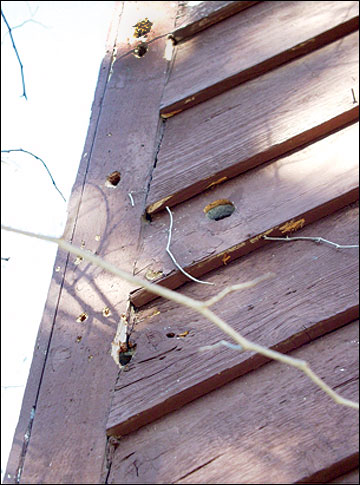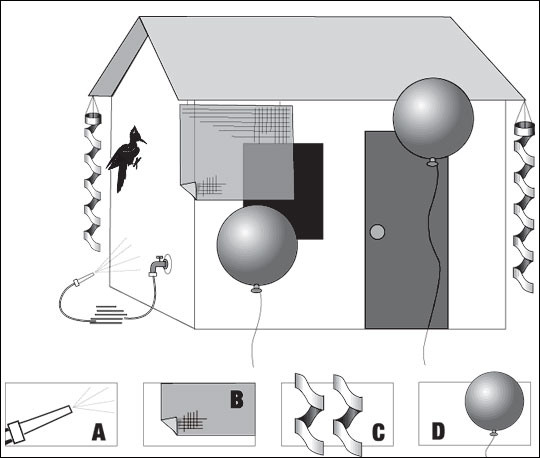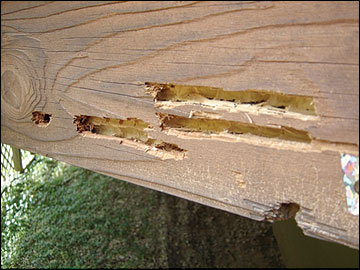More than 200 species of woodpeckers exist, about 45 species live in the United States, and depending on the season, seven species can be found in Missouri. Woodpeckers nest and roost in holes or cavities in trees, which they usually excavate themselves. The woodpecker’s preferred habitat is a mature forest with standing dead trees, snags or older living trees with dead limbs, though several species have adapted to habitats found in urban and suburban residential areas with mature trees.
Many people like to watch woodpeckers and try to attract them to their home landscapes. Although watching and feeding woodpeckers throughout the year can be enjoyable, woodpeckers can cause extensive damage to buildings and houses — in urban as well as rural areas. Most people experiencing woodpecker damage live in or within half a mile of a wooded area containing large hardwood trees. As more people and housing developments move into wooded areas, woodpecker damage problems will likely increase.
Woodpecker species in Missouri
The following seven woodpecker species are found in Missouri.
- Northern Flicker (Colaptes auratus)
A common year-round resident, the Northern Flicker prefers open woodland habitats in rural and suburban areas and often feeds on the ground. - Red-headed Woodpecker (Melanerpes erythrocephalus)
Also a year-round resident in Missouri, the Red-headed Woodpecker can be found in a variety of habitats, including open woodlands, mature forests, farmlands and urban parks with mature trees. - Hairy Woodpecker (Picoides villosus) and Downy Woodpecker (Picoides pubescens)
Similar in appearance, Hairy and Downy woodpeckers are mostly black and white. The Downy Woodpecker is the smaller species and lives in all types of woodlands, from mature forests to small urban woodlots. The slightly larger Hairy Woodpecker has a longer bill and is also commonly found in a variety of forest and woodland habitats. - Red-bellied Woodpecker (Melanerpes carolinus)
A year-round resident, the Red-bellied Woodpecker is common in open woodlands, suburbs and parks. - Pileated Woodpecker (Dryocopus pileatus)
The largest woodpecker in Missouri, the crow-sized Pileated Woodpecker usually prefers extensive, mature forests but can be found in smaller woodlots, parks and suburbs. - Yellow-bellied Sapsucker (Sphyrapicus varius)
The Yellow-bellied Sapsucker migrates to Missouri in winter, usually arriving in October and leaving by late April, and can be found in mixed hardwood and pine forests throughout the state.
Biology and habits
Woodpeckers are an interesting and familiar group of birds. Their habit of pecking into trees in search of food or to excavate nest cavities is well known. They prefer snags or partially dead trees for nesting sites and will readily peck holes in trees and wooden structures in search of insects beneath the surface. A common misconception is that they peck holes in buildings only in search of insects, but many species drill holes in sound, dry wood where no insects exist.
Woodpeckers not only have characteristic calls but they also use a rhythmic pecking sequence, or “drumming,” to make their presence known. They instinctively make their noise on trees, branches, drain spouts, utility poles, streetlights, TV antennas, silos and other structures that resonate loudly. This drumming establishes their territory, similar to most other birds’ singing, and may also attract a mate, which is why drumming activity is at its highest in spring.
Drumming is also used to locate food. A woodpecker taps on a tree, listens for movement of insects under the bark, and drills only when it hears sound inside. This behavior saves the bird the effort of drilling into numerous trees only to find them empty. Similarly, a woodpecker taps on trees to find one suitable for nesting.
A woodpecker’s bill is straight, sturdy and sharply pointed. Woodpeckers use their bills to chisel through or under bark in search of wood-burrowing insects, grubs, spiders and ants and to chisel out nesting and night-roosting cavities.
Woodpeckers’ tongues have special adaptations that enable the birds to capture and eat insects. Sapsuckers, which are true woodpeckers, obtain insects by pecking rows of small holes through the bark of live trees and lapping up insects attracted to the sap, as well as the sap itself, with the help of the small brushlike bristles on their tongues.
A woodpecker’s tail and feet anchor the bird firmly to a tree trunk, its strong neck muscles provide the force necessary to drill holes, and the bristly feathers around its nostrils filter the wood dust as it chisels.
Woodpecker damage prevention and control
The key to successful damage control is to take action as soon as a woodpecker shows signs of becoming a nuisance. Once the bird has established its drumming behavior, breaking it of the habit is difficult.
No one knows why certain birds are attracted to houses, but natural wood (especially cedar) siding, large size, and better sound production may make houses seem like “super trees.” Cedar-sided homes in particular experience a high incidence of damage, which may reflect either woodpecker selection or the frequent selection of cedar as a building material in wooded areas.
Woodpecker damage to wood siding may be smooth round holes or rough vertical gashes from 1 to several inches long. It may be restricted to a small area, often in a high corner of the building, or it may be quite extensive (Figure 1). Large round holes are probably intended to be nesting or roosting cavities. Rows of extensive damage across the siding may be a result of foraging, or searching for insects behind the siding.
Examine the locations of the drumming. The woodpecker must be able to hold onto the structure to drum, so first consider removing all ledges, cracks and crevices that might serve as toeholds. This may solve the problem. If it does not, or if damage is such that specific control is necessary, other control methods may be applied (Figure 2). All species of woodpeckers can be controlled in similar ways, though individual birds may react differently. Control methods can include a variety of integrated damage management techniques such as scaring birds from the area, excluding them from a particular site and repelling them with visual or tactile repellents.
 Figure 1. Woodpeckers can cause extensive damage to wood siding.
Figure 1. Woodpeckers can cause extensive damage to wood siding.

Figure 2. Woodpecker damage-control methods for structures: (a) high-pressure water hose, (b) fine-mesh netting, (c) highly reflective aluminum foil strips or Mylar tape, (d) helium-filled Mylar balloon.
Exclusion and scare tactics
Woodpeckers can be very persistent and are not easily driven from their territories or selected pecking sites. So, to be effective, visual or sound types of frightening devices for protecting buildings should be used as soon as the problem is identified and before territories are well-established.
Loud noises such as handclapping, shooting a toy cap gun and banging on a garbage can lid may frighten woodpeckers away from houses. Spraying the bird with a high-pressure water hose can also be effective (Figure 2a). Such harassment, if repeated when the bird returns, may cause it to leave for good.
Excluding the bird from a favorite drumming site may be possible with the use of lightweight, plastic bird netting (3/4-inch mesh). Attach the netting to the overhanging eaves and angle back to the siding below the damage area (Figure 2b). When properly secured, the netting is barely visible from a distance and offers a long-term solution to the damage problem.
Areas of concentrated damage can be temporarily screened with poultry wire, hardware cloth, plastic sheets or netting. Surfaces that are damaged repeatedly may have to be permanently protected with metal sheeting, which can be disguised with paint or simulated wood grain to match the siding. Aluminum flashing is easy to work with to cover damage sites.
Visual repellents
Visual repellents can be used to chase or scare birds away. The most common visual repellents are aluminum foil strips or reflective Mylar tape (Figure 2c); pie pans or brightly colored plastic strips; bright tin lids; pinwheels; and helium balloons (Figure 2d) or suspended falcon silhouettes. Each of these visual repellents depends on motion, provided by breezes, to frighten birds. Descriptions of how to use several of these visual repellents are provided below.
Aluminum foil strips
- Cut aluminum foil into several strips 2 to 3 inches wide and 2 to 3 feet long.
- Attach a 6-inch string to one end of each strip.
- Partially hammer in small brads or nails 2 to 3 feet above the drumming site, spaced 6 to 10 feet apart.
- Attach the free end of each string to a nail so foil strips hang freely and move with every breeze.
Reflective Mylar tape
- Reflective Mylar tape, sometimes marketed as “bird scare tape,” may discourage and frighten woodpeckers. The holographic tape that reflects rainbow colors seems to be more effective than the red or silver tapes. As an alternative to using aluminum foil strips, stretch reflective tape strips across the damaged area or attach them to the eaves and let them hang down, weighted or unweighted.
Pinwheels
- Pinwheels with reflective vanes are most effective. Attach them at the drumming site with brads, nails, pins, small staples or tape. Be certain vanes can move freely. If necessary, put a backing behind the stick to free the pivot.
Balloons
Stationary model hawks or owls, fake and simulated snakes, and owl and cat silhouettes are generally ineffective as repellents. Large rubber balloons filled with helium with owl-like eyes painted on them are included in the recent array of frightening devices used to scare woodpeckers.
Other repellents
Sticky, paste-type repellents applied in the damaged area have been effective for some problems. These repellents may stain, so they should be applied on masking tape and not directly on a wood surface. They also may streak siding if temperatures rise high enough that they melt and run.
Taste repellents
Although chemicals with objectionable tastes and odors, such as Ro-pel and Thiram, have been used to treat utility poles and fence posts to discourage woodpeckers, most have proven ineffective or at least not cost-effective.
Tactile repellents
Sticky or tacky bird repellents, such as Tanglefoot, Bird Stop and Roost-No-More, often will discourage the birds when smeared on limbs or trunks of high-value orchard, park or yard shade trees where woodpeckers are drilling. They also may discourage the birds when applied to wood siding and other areas with structural damage.
Other control methods
Suet stations
During the winter, many bird-watchers put out beef suet to attract woodpeckers. Placing suet stations near damaged buildings has been recommended to entice birds away from buildings or damaged area, but it may also attract additional woodpeckers to the area, which could lead to more damage. Most damage caused by woodpeckers seems to be unrelated to feeding behavior, so why suet stations are sometimes effective is unclear.
During the warmer months, offering suet may be harmful to the birds. Besides making them dependent on handouts, the suet reportedly gets onto the feathers of the head, which could lead to matting and eventual loss of feathers.
Alternate nesting and drumming sites
Consider the needs of woodpeckers as you plan your landscaping activities. Leaving large dead limbs on trees may reduce damage to your house by providing a place for woodpeckers to nest and find food. Installing nest boxes in trees could also provide an alternate nesting site.
Building an alternate drumming site may also reduce the amount of damage to the house. Fasten a cedar board securely to the pecking site and attach a second board loosely to one end of the first board. These two boards should overlap to form a flexible, resonating surface. A simple hollow box also may serve an effective drumming site.
Insect removal
Fall damage often results from woodpeckers searching for food, usually insects or insect larvae, in or under the siding. Certain types of plywood siding contain tunnels that are opened when the plywood is grooved. Insects, especially leaf-cutting bees, enter these tunnels for winter shelter or to lay eggs. If woodpecker holes are arranged in neat, regular rows, insects inside such tunnels are probably attracting the birds. Removing the insects should eliminate this problem. Caulk all the tunnels in the siding. Insecticides or wood preservatives may help in some situations, though making insecticide applications into the siding to kill the insects is usually difficult.
Carpenter bee infestations and woodpeckers
Woodpecker damage to wooden structures such as the railings, joists and steps of decks may indicate a carpenter bee infestation. Carpenter bees excavate cavities in solid wood structures at least 2 inches thick for shelter and rearing of young. The entrance hole will be a perfect circle about 1/2 inch in diameter. The bee will go straight into the wood about an inch and then turn 90 degrees and begin making long tunnels and chambers that follow the grain of the wood. If woodpeckers locate these bee nests, they will begin to excavate the bee’s cavities and eat the larvae. As a woodpecker pecks into the tunnels and cavities, it creates long, jagged gashes in the wood that may be 1/2 inch or deeper (Figure 3). If you see this type of woodpecker damage, look for the round entrance holes the bees have made. Carefully inspect the insides of the gashes and you will see the smooth bore marks made by the bees. Refer to MU Extension publication G7424, Carpenter bees, for prevention and control recommendations. Controlling the carpenter bee problem will in turn solve the woodpecker problem.
 Figure 3. Woodpeckers may damage wood siding in search of foods such as carpenter bee larvae.
Figure 3. Woodpeckers may damage wood siding in search of foods such as carpenter bee larvae.
Protecting against Yellow-Bellied Sapsucker damage
Sapsuckers are specialized woodpeckers that excavate numerous rows of squarish holes around the circumference of the trunks and larger limbs of many tree and shrub species (Figure 4). Sap, a high-energy food source, flows from these holes and attracts insects, which the sapsuckers lick up with their bristled tongues.
Sapsucker activity rarely permanently damages or actually kills a tree. A tree that is attacked year after year, however, may suffer from lowered vitality and be exposed to injury by insects and disease; and occasionally, a tree is completely girdled and dies. Damage most often occurs to ornamental yard trees, but in wintering areas and during migration, sapsuckers sometimes congregate in orchards and cause significant damage.
An individual sapsucker will often pick a favorite tree and visit it repeatedly, causing unsightly wounds, and possibly leading to disease and insect problems. An individual tree is best protected by draping plastic or nylon netting over the entire tree or by placing loose cylinders of hardware cloth around its trunk and limbs. Migrating or wintering sapsuckers cause much of this damage, so these barriers are needed only seasonally and usually for a short time. To prevent further damage, wrap the damaged part of the tree with burlap or hardware cloth, or smear a sticky repellent such as Tanglefoot Bird Repellant on the trunk. Reflective Mylar strips attached vertically to the trunk can also be a useful repellent.
Protecting a home from sapsucker damage is often not worth the time or the effort because the damage is less serious than that caused by other species and is easier to deal with.
Laws and regulations
Woodpeckers are beneficial birds that feed mostly on insects. They are classified as migratory, nongame birds and are fully protected by the Federal Migratory Bird Treaty Act. Thus, woodpeckers are protected by both state and federal laws. If nonlethal damage prevention methods fail and significant damage has occurred, when warranted, woodpeckers can be lethally removed. Permission to perform such removal may be granted, but only under a depredation permit issued by the Migratory Bird Division of the U.S. Fish and Wildlife Service. A Form 37 from USDA APHIS Wildlife Services (the Wildlife Services program of the U.S. Department of Agriculture’s Animal and Plant Health Inspection Service) must accompany the request for a depredation permit. The depredation permit is required before any person may take, possess or transport migratory birds for depredation control.
 Figure 4. Sapsuckers typically excavate rows of holes around the circumference of a tree trunk or limb in search of food.
Figure 4. Sapsuckers typically excavate rows of holes around the circumference of a tree trunk or limb in search of food.
Additional information
For information on depredation and other federal permit conditions, contact:
- USDA APHIS Wildlife Services
1714 Commerce Court, Suite C
Columbia, MO 65202
573-449-3033
Additional information can be found on the following websites:
Brand names appearing in this publication are for product identification. No endorsement is implied, and no discrimination is intended.